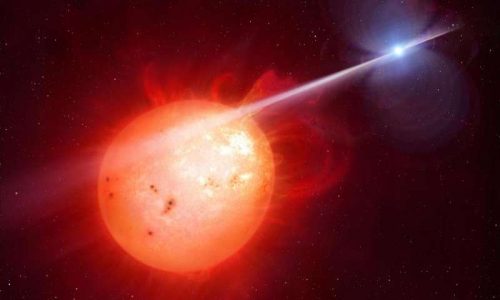The star duo in AR Sco is spinning fast. The white dwarf whips at its neighbor - a red dwarf - a powerful beam of ionized particles and radiation, causing the entire system to glow and pale radically every two minutes

An exotic double star system located about 380 light years away has been identified as a white dwarf pulsar - the first ever discovered. This is reported by researchers from the University of Warwick.
Tom Marsh and Boris Gusick of the Astronomy Group at the University of Warwick and Dr David Buckley of the Dorm Africa Astronomical Observatory have identified the star AR Scorpii (AR Sco) as the first ever version of a white dwarf pulsar. The system was discovered already in the sixties and was classified as containing neutron stars.
The white dwarf pulsar has eluded astronomers for over fifty years. The star duo in AR Sco is spinning fast. The white dwarf whips at its neighbor - a red dwarf - a powerful beam of ionized particles and radiation, causing the entire system to glow and pale radically every two minutes.
The researchers say that such a focused beam directed in one direction - like a particle accelerator is a unique phenomenon in the entire known universe.
AR Sco is in the direction of the constellation Scorpius at a distance of 380 light years from Earth, a close neighbor in astronomical terms. The diameter of the white dwarf in AR Sco is the same as the Earth but its mass is 200 thousand times heavier, and it orbits every 3.6 hours the cold red dwarf that has a mass of about one third of the Sun's mass.
With a magnetic field 100 million times stronger than on Earth, and a self-spinning of just under two minutes, AR Sco produces a beacon-like beam of radiation and particles that hits the face of the cold red dwarf star when it is aimed in front of it.
This is the most powerful beacon effect of accelerating electrons into the atmosphere of a red dwarf near the speed of light, an effect that has not been observed before in similar types of binary stars. The red dwarf receives rotational momentum thanks to the kinetic energy of its spinning neighbor.
The distance between the two stars is about 1.4 million kilometers, about 3 times the distance of the Moon from the Earth.
Professor Thomas March comments: "The new data show that the light from AR Sco is highly polarized, indicating that the magnetic field dominates the radiation from the whole system. A weaker version of such behavior has also been observed in binary systems containing pulsars that are neutron stars. His research partner, Prof. Boris Gansik adds: "AR Sco is like a giant dynamo - a star the size of the Earth with a magnetic field 10,000 times stronger than any field we are able to produce in the laboratory and spins every two minutes. This creates a huge flow of electrons and this is expressed in the light we perceive from the system."
The research was published in the journal Nature Astronomy.

3 תגובות
Pulser thanks for your comment.
It seems to me, then, that the pulsar has two self-rotating components.
One plane of rotation - the plane perpendicular to the beam, and it actually creates the magnetic field that accelerates the beam.
This rotation should be very fast and create a very strong magnetic field.
The second rotation plane - the precession rotation of the beam itself.
Since the strong glow is visible every two minutes, the pulsar completes a complete spin every 4 minutes.
To illustrate the idea, you can see the following demo:
https://he.wikipedia.org/wiki/%D7%A0%D7%A7%D7%99%D7%A4%D7%94#/media/File:Gyroscope_precession.gif
2 minutes is the rotation time of the pulsar around itself
It is not clear,
If the cycle time of the system is 3.6 hours (lap time) then,
What is the explanation for the system glowing and fading every 2 minutes?